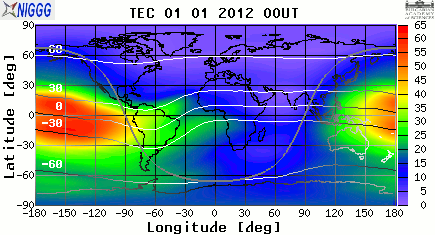 |
|
 |
Two global empirical TEC models are built by using the Center for Orbit Determination of Europe (CODE) TEC data (ftp://ftp.aiub.unibe.ch/CODE/) for full 13 years, 1999-2011. The background TEC model (for details see the two PDF files, [PDF1], [PDF2]) offers 31-day running median TEC maps for a month ahead at a given UT. The TEC model response to geomagnetic activity (for details see the PDF file) presents a current and 24 hours ahead TEC maps.
The work on the TEC models was supported by the European Office of Aerospace Research and Development (EOARD), Air Force Office of Scientific Research, Air Force Material Command, USAF, under grant number FA8655-12-1-2057 to D. Pancheva (for contact).
| 1. Global empirical background TEC model | 2. Global empirical model of TEC response to geomagnetic activity |
|
The hourly median TEC maps for January 01, 2012 are shown where the development of the Weddell Sea Anomaly can be clearly reproduced by the background TEC model. |
The geomagnetically forced TEC anomalies, expressed by the relative deviation of TEC from its 15-day median (rTEC) for October 29 - November 01, 2003 demonstrate the global TEC response to the famous Halloween geomagnetic storm. A detailed comparison between the data and model see HERE |

Вижте повече... |

Вижте повече... |